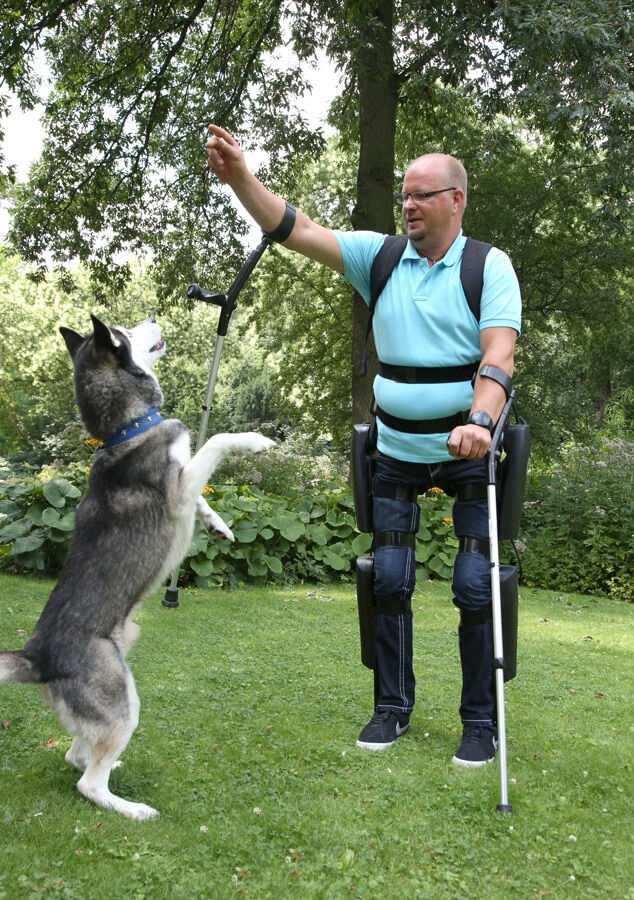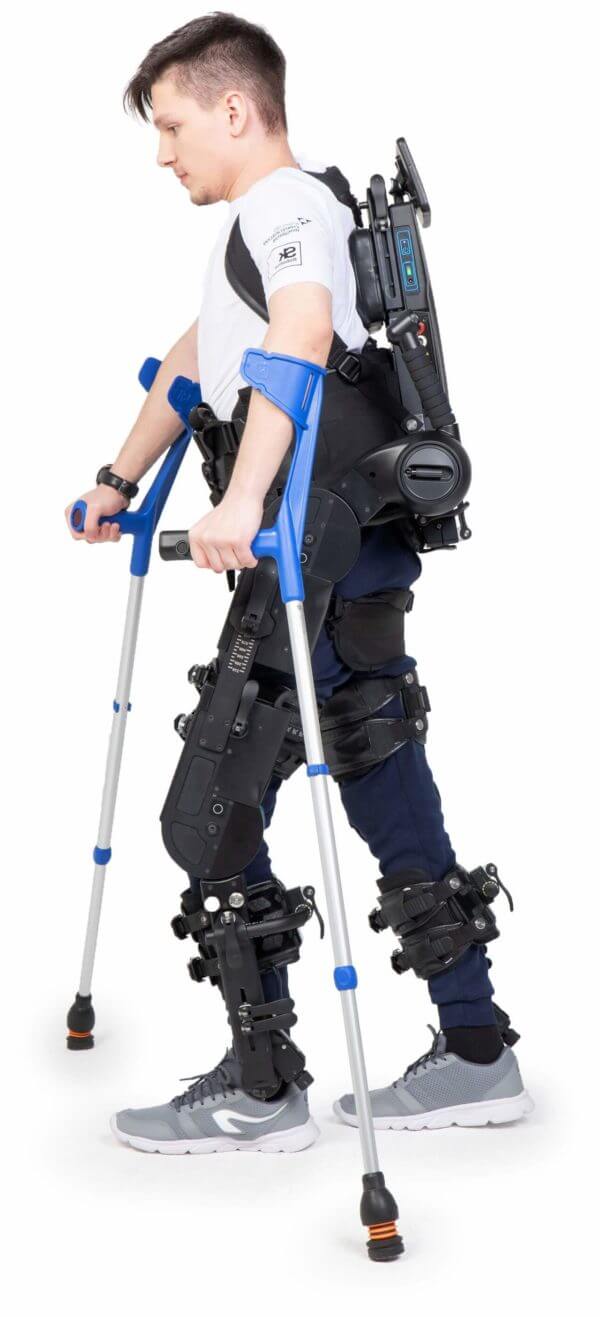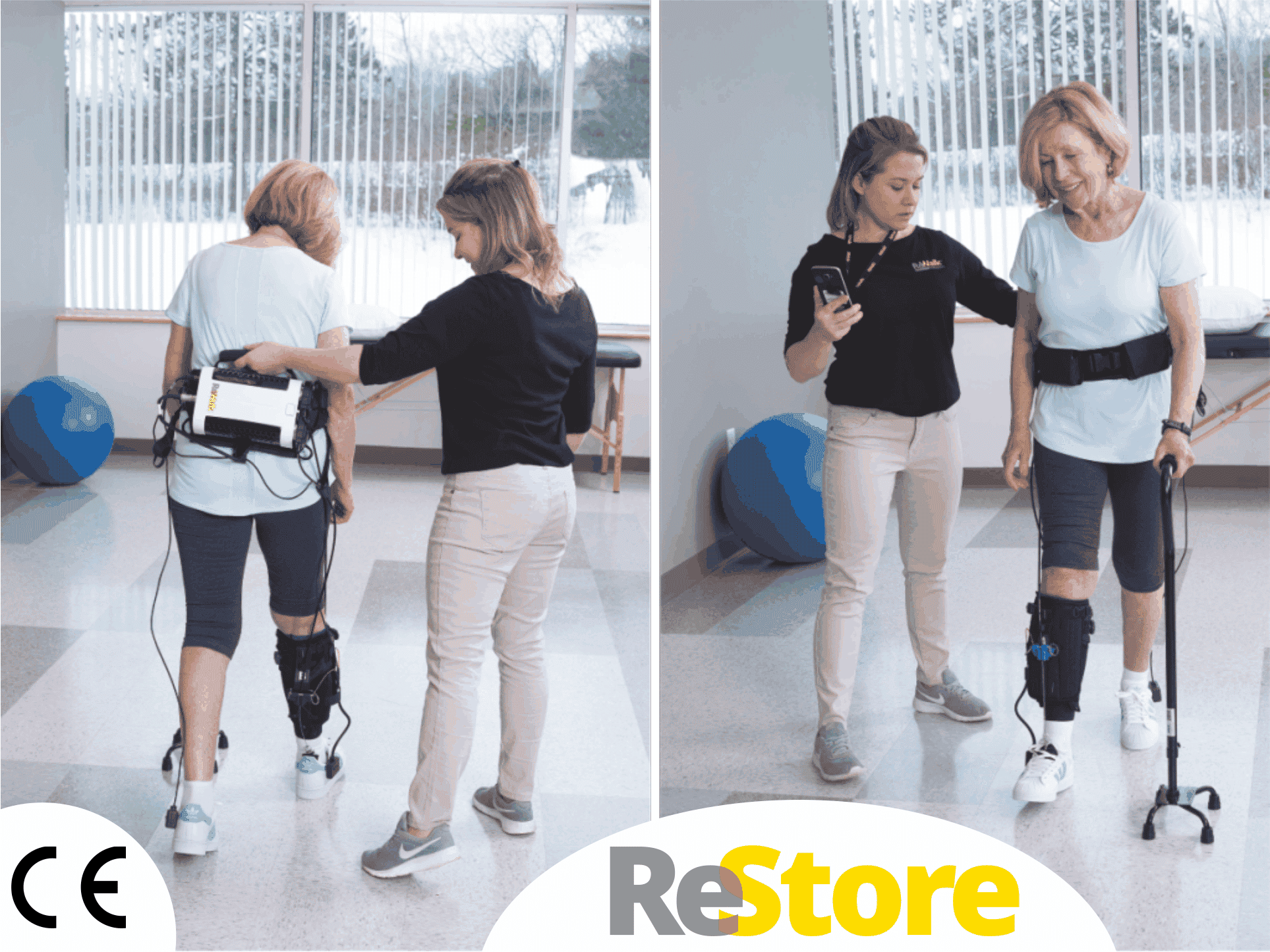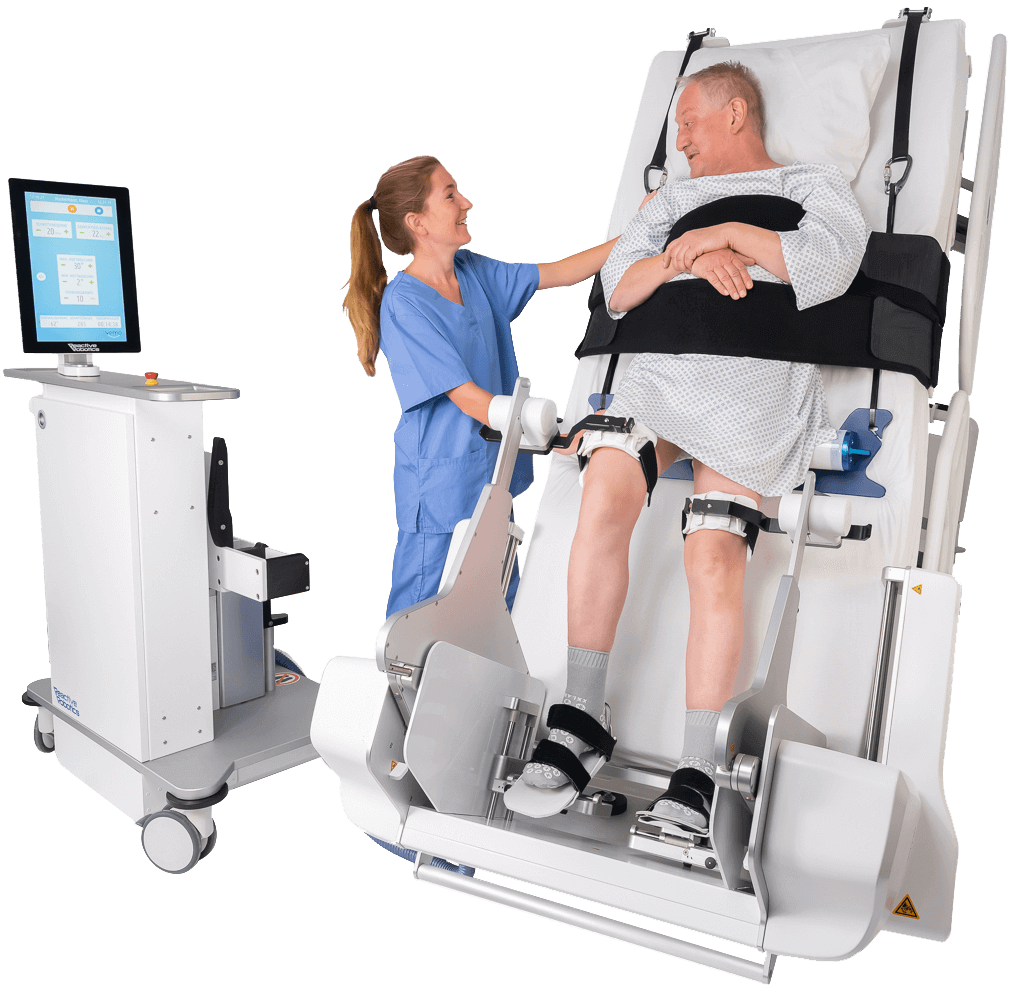Im folgenden Ratgeber finden Sie alle notwendigen Informationen und alle weltweiten verfügbaren Produkten zum Thema Exoskelette für die Rehabilitation (zum Beispiel nach einem Schlaganfall oder bei MS) und Exoskelette als private Nutzung im Alltag für Menschen mit Handicap.
Zusammenfassung Exoskelette für die Rehabilitation und als Hilfsmittel für die private Nutzung:
Medical exoskeletons as well as exoskeletons as aids have a supporting role in healthcare and rehabilitation. They are clearly different from exoskeletons from industry, because exoskeletons as aids are used for rehabilitation and not for prevention. For example, they enable patients with neurological diseases to learn to walk again more quickly or to communicate at eye level in society. For private users, an exoskeleton enables them to regain a feeling of independence and autonomy in their home environment. A social stigma is transformed into a real technological eye-catcher with a small talk guarantee. But exoskeletons are also revolutionizing the speed of recovery in rehab. If previously two physiotherapists completed few hundreds of steps in a training day with a stroke patient, with an exoskeleton it could be several thousand with only one physiotherapist. Training efficiency is increased tremendously. In the following guide you will find an overview of all existing exoskeletons, all manufacturers that are approved or applicable as assistive devices used in medicine or rehabilitation, as well as an overview of all myoelectric orthoses All assistive devices exoskeletons are sorted for you by indications, weight, body size and much more. You can compare the solutions on your own or use our free & non-binding consultation.
Why do medical exoskeletons help a patient as an assistive device?
The primary goal of our customers is to improve their own mobility, restore their independence and not be excluded from society. Exoskeletons can therefore not only serve to compensate for disabilities, but also enable users to actively participate in life again.
Exoskeletons for MS patients and exoskeletons for neurological diagnoses:
Most active exoskeletons (curative solutions) are recommended for the following diagnoses: MS, paraplegia, stroke and Parkinson's disease.
Especially the use for MS patients and stroke patients is in the foreground.
There are a variety of new solutions here:
If you are wondering which exoskeleton should be used for MS, the good news is that yes, there are exoskeletons for MS patients. The exoskeletons in everyday use have been developed for MS patients, among others. Furthermore there is the Mollii Suitwhich was developed for MS, Parkinson's disease and spasticity. Exoskeleton multiple sclerosis capable are further Myoswiss and Keoogo, both exoskeletons that require little residual muscle function. In case of complete paralysis we recommend ReWalk. Furthermore, the EksoNR the first exoskeleton approved by the FDA (USA) for the rehabilitation of MS patients, which significantly expands the use of the device to a broader patient population. Alternatively, there is also the Naural sleeve as an alternative to conventional solutions. We often recommend the Keeogo and MyoSuit for patients with residual muscle function, when the ability to walk is still given up to ten steps. After that, we often recommend the ReWalk or Indego.
Medical exoskeletons as well as exoskeletons in rehabilitation or as aids in personal use differ in more than 80 factors. There are significant differences such as the weight of the user, body size, price and indication, but also peripheral factors such as volume, battery duration, stair climbing function and residual muscle function strength. We have tested all exoskeletons on the market for you and listed some differences:





Advancing technology has led to significant developments in the field of medical exoskeletons in recent years. These state-of-the-art devices offer people with various neurological impairments, such as multiple sclerosis (MS), paraplegia and stroke, the opportunity to improve their mobility, independence and quality of life. Medical exoskeletons have found widespread use both in everyday life and in rehabilitation facilities, opening up new perspectives for a more active life for those affected.
Medical exoskeletons in everyday life:
For people with MS, paraplegia or stroke, everyday life can often be fraught with challenges, especially when it comes to movement and mobility. Medical exoskeletons offer a private solution here, enabling those affected to manage everyday activities more easily. Simple things like climbing stairs, walking on uneven terrain or lifting objects can be a huge challenge for individuals with motor impairments. Exoskeletons assist the wearer by supporting and amplifying movements. For example, the joints of the exoskeleton can be powered by servo motors, allowing the user to move more easily and reduce physical strain.
The use of a medical exoskeleton in everyday life enables people to increase their independence and lead an active life. It improves their ability to independently perform daily tasks and engage in social activities. By using an exoskeleton, these individuals can overcome the challenges of their impairments and achieve a higher level of quality of life.
Another advantage of medical exoskeletons as a private solution in everyday life is that they can reduce or even avoid the need for extensive structural adaptations in infrastructure. Because exoskeletons enable users to climb stairs and move around in different environments, barriers are removed and inclusion is promoted. This is especially important because barrier-free access and disability-friendly infrastructure often come at a high cost. Exoskeletons can thus be a more cost-effective and efficient alternative to support people with mobility impairments and enable them to fully participate in social life.
Medical exoskeletons in rehabilitation facilities:
Medical exoskeletons have also found an important place in rehabilitation facilities. They are increasingly used as a complementary therapy method to support the rehabilitation of patients with neurological impairments. In rehabilitation facilities, exoskeletons can be used specifically to improve patient mobility, restore muscle strength and train walking ability.
For patients with paraplegia or stroke, using an exoskeleton can be a transformative experience. It allows them to stand upright and walk again with the help of exoskeleton technology. This can be a tremendous motivator and confidence booster, not only physically, but psychologically as well. Continued use of an exoskeleton in rehabilitation can help promote neuroplastic changes in the brain and aid in the regeneration of damaged neural pathways.
Another advantage of exoskeletons in rehabilitation facilities is that they can reduce the risk of injury to medical staff. For example, exoskeletons allow patients to be lifted and transferred with less effort and strain on caregivers, which can improve working conditions in the long term.
In summary, medical exoskeletons represent a groundbreaking technology that offers people with MS, paraplegia and stroke a private solution for a more active life. The potential uses in everyday life enable those affected to increase their independence and overcome barriers. At the same time, exoskeletons in rehabilitation facilities have the potential to revolutionize patient rehabilitation and improve the effectiveness and efficiency of therapy. The ongoing development of this technology will undoubtedly help medical exoskeletons to take on an even more significant role in medical care and rehabilitation and improve the lives of many people in the long term.
Exoskeleton legs: There are no single exoskeletons for the legs. There are exoskeletons knee systems like the computer controlled leg orthoses C-Brace such as from Ottobock or exoskeletons for the lower body (see everyday use). If you want to buy an exoskeleton knee, please contact us. A knee exoskeleton is primarily covered by the health insurance if the conditions are complete. There are special exoskeleton knee osteoarthritis systems and some for other special diagnoses. Let us advise you.
For hiking is especially the exoskeleton Myosuit from Myoswiss is suitable. You can also find an exoskeleton for walking at the category everyday use. All these exoskeletons are designed for walking in your own private environment.
Exoskeleton for paraplegic patients also exists. Using exoskeletons for paraplegia makes a lot of sense. In case of complete paralysis and no residual muscle function, we recommend the Personal 6.0 from Rewalk or the Phoenix. In cross-section, exoskeletons still play an important role, because sitting in a wheelchair for a long time often causes bladder infections. This is thus avoided.
As patients are gradually reaccustomed to movement with the help of the support apparatus, "lost motor skills can be regained," according to studies (118, pages 130-137 2015, Exoskeletons for rehabilitation of patients with spinal cord injuries). For example, reaching for stands and lifting are significantly supported. The control system is usually mounted on the exoskeleton itself. The muscle activity is then intuitively supported in one of three modules.
In principle, exoskeletons are walking orthoses worn on the body that enable the wearer with a spinal cord injury to stand and walk independently again with the help of motorized hips and knees and, depending on the model, to climb or descend stairs again. The walking orthoses enable independent and controlled walking, mimicking the natural movement of the legs. Exoskeletons can be used all day long, both outdoors and at home.
Visit our guide by diagnosis. Here you will find an overview for exoskeleton for disabled, exoskeleton paraplegia, exoskeleton for legs, exoskeleton for knees, Exoskeleton for MS patients and much more.
You will not be able to do without a wheelchair completely. However, an exoskeleton walker supports you more than a wheelchair does, because you gain eye level. If you are looking for a wheelchair, we recommend Scewo. However, the exoskeletons in everyday life support you as exoskeletons when walking for more self-determination and freedom in your own four walls and outside. Alternatively, there is as an exoskeleton for wheelchair users the Roki Wheel and the premium wheelchair Scewo if the requirements are not fully met. For residual muscle function in the legs we recommend Keoogo and Myoswiss, in case of complete residual muscle function loss ReWalk. An exoskeleton wheelchair system is not currently on the market.
Yes there is an exoskeleton forearm system (exoskeleton arm system) like from Myomo, an exoskeleton hand or also called myoelectric hand from Ottobock or Vincent Systems. If you want to buy an exoskeleton arm among others, please contact us! If you are looking for more information about myoelectric solutions, feel free to visit our guide.
Exoskeleton rehab systems have been specially developed. You will find these described and objectively presented above. Exoskeleton rehab suitable are most of the solutions of the providers described above. So there are special exoskeleton stroke systems, really exoskeleton after stroke suitable systems, which were built and researched only for this purpose. Exoskeleton therapy is usually required for neurological conditions. If you are looking for more information, feel free to visit our comprehensive guide.
No. For example, there are no specific exoskeleton motorcycle solutions, also called motorcycle exoskeleton, only systems with which you can drive a car. Also, there is no specific exoskeleton Parkinson's package, but solutions that can be considered for Parkinson's, among others.
Are you looking for exoskeleton physiotherapy? Contact us! Please note our disclaimer.